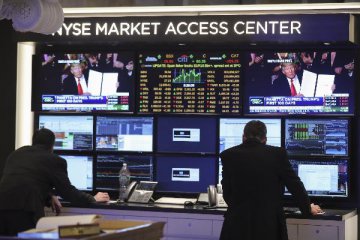In the week ending March 8, the Dow fell 2.23 percent, the S&P 500 was down 2.17 percent, and the Nasdaq declined 2.49 percent. This week marked choppy trading sessions for the market with a negative start and a notched five-day losing streak.
On Friday, the three major indices ended lower, as investor sentiment was dented by gloomy U.S. job report in February that largely fell short of market expectations, raising worries over a slowing U.S. economy.
Friday extended solid loss throughout the day, after U.S. job report in February missed analysts' forecasts, with a slight employment increase.
The Dow Jones Industrial Average was down 22.99 points, or 0.09 percent, to 25,450.24. The S&P 500 decreased 5.86 points, or 0.21 percent, to 2,743.07. The Nasdaq Composite Index was down 13.32 points, or 0.18 percent, to 7,408.14.
Shares of Exxon Mobil fell over 1.4 percent around market close on Friday, as U.S. investment bank Cowen downgraded the stock of the U.S. oil and gas giant to "market perform" from "outperform," due to concerns over the latter's long-term dividend commitment.
Yet shares of Costco rose nearly 5.1 percent, after the U.S. retailer reported fourth-quarter profit that exceeded market expectations.
The market was further pulled down by the ECB's moves to cut its economic growth forecast for 2019 on Thursday, fueling anxiety over a worsening global economy.
ECB President Mario Draghi said Thursday that the central bank slashed its growth forecast to 1.1 percent, down from an estimate of 1.7 percent released in December last year.
He noted that a "sizable moderation in economic expansion" would extend into the current year. Due to weakening European economy, the ECB also lowered its inflation forecast for 2019 to 1.2 percent.
"The persistence of uncertainties related to geopolitical factors, the threat of protectionism and vulnerabilities in emerging markets appears to be leaving marks on economic sentiment," Draghi told reporters.
The U.S. international trade deficit in goods and services shot up to 59.8 U.S. billion dollars in December 2018, up a striking 18.8 percent from November's 50.3 billion dollars, the Commerce Department said Wednesday.
The widening trade gap came as imports rose 2.1 percent to 264.9 billion dollars, while exports fell 1.9 percent to 205.1 billion dollars.
The monthly deficit marks a record high since 2008 and is well above market expectations, despite President Donald Trump's trumpeting of attempts to narrow it.
Investors also digested the latest beige book of U.S. Federal Reserve released on Wednesday. Ten of the Federal Reserve's 12 districts saw "slight-to-moderate" growth in late January and February, while St. Louis and Philadelphia reported "flat economic conditions," according to the Beige Book.
Six Fed districts have suffered slower economic activity in some sectors due to the 35-day government shutdown in late December and most of January, including retail, auto sales, tourism, real estate, restaurants, manufacturing, and staffing services, said the Beige Book.
Eric Rosengren, president of the Federal Reserve Bank of Boston, stressed on Tuesday patient observation on how the U.S. economy develops and prudent management of risks in terms of the Fed's further monetary policy.
"It may be several meetings of the Federal Open Market Committee before Fed policymakers have a clearer read on whether the risks are becoming reality and by how much the economy will slow compared to last year," Rosengren said in Boston.
On the economic front, total nonfarm payroll employment slightly rose by 20,000 jobs in February, and the unemployment rate declined to 3.8 percent, the U.S. Bureau of Labor Statistics said Friday.
Both figures miss market forecasts, and mark the weakest month for job creation since September 2017.
The net worth of U.S. households and nonprofits dropped, for the first time in more than three years, to 104.3 trillion dollars in the fourth quarter of 2018, according to figures released Thursday by the U.S. Federal Reserve.
Nonfarm business sector labor productivity rose 1.9 percent in the fourth quarter of 2018, up 1.8 percent year on year, the U.S. Bureau of Labor Statistics said Thursday.
The increase came as output was up 3.1 percent and hours worked up 1.2 percent, pointing to a strong labor sector.
New single-family houses sales jumped 3.7 percent in December 2018 to an annual rate of 621,000 units, marking a seven-month high since May 2018, the U.S. Census Bureau said in its latest monthly report on Tuesday.
Economic activity in the non-manufacturing sector reported continuous growth in February, the Institute for Supply Management (ISM) said in its latest Non-Manufacturing ISM Report on Business on Tuesday.
The Non-Manufacturing Index registered 59.7 percent, 3 percentage points higher than the January reading of 56.7 percent. "This represents continued growth in the non-manufacturing sector at a faster rate," said ISM.
U.S. construction spending sank 0.6 percent in December 2018, with year-on-year growth falling to 1.6 percent, the weakest growth rate in at least three years, the U.S. Census Bureau said Monday.
The unexpected drop came following a 0.8-percent increase in November as spending in private residential construction declined 1.4 percent in the month.





















Latest comments